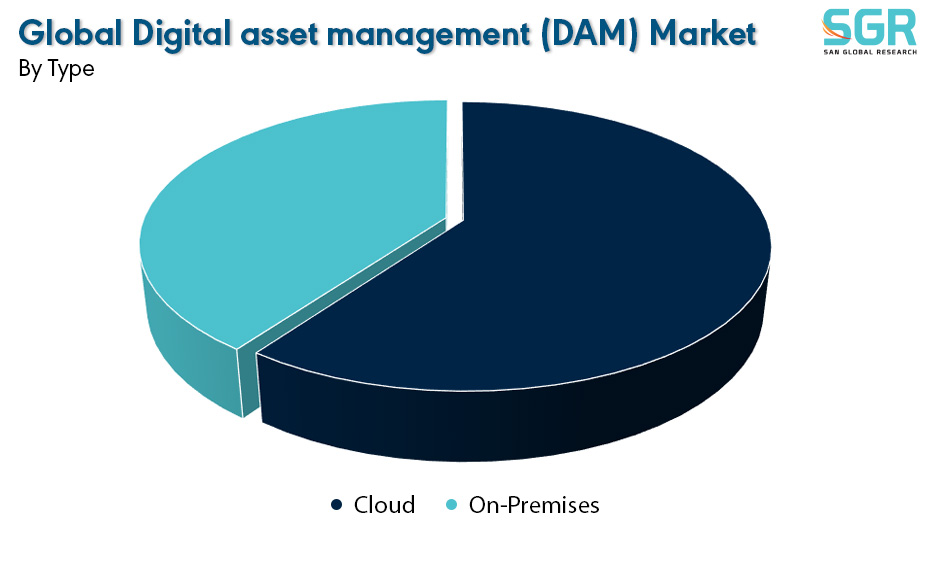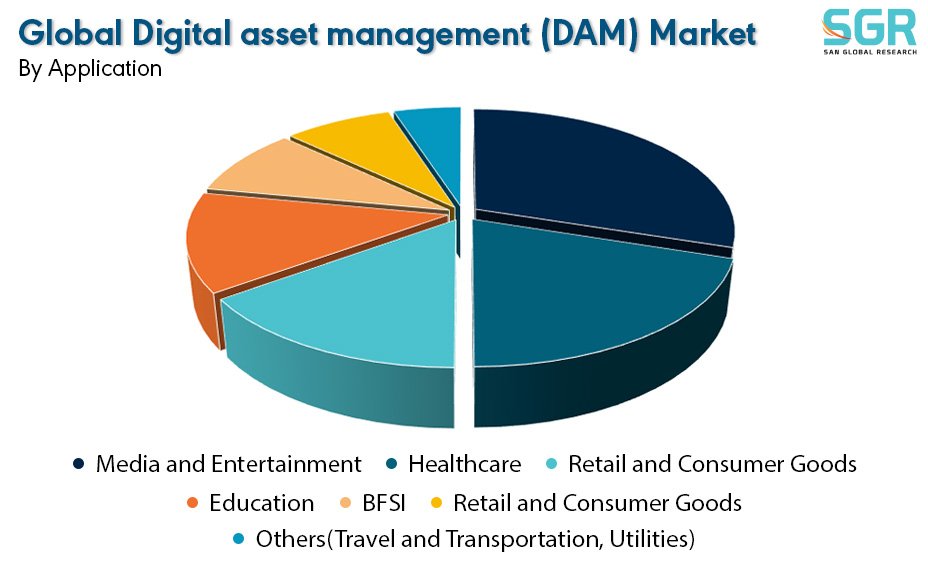Digital asset management (DAM) Market is estimated to be worth USD 4.06 Billion in 2023 and is projected to grow at a CAGR of 17.24% between 2023 to 2032. The study has considered the base year as 2022, which estimates the market size of market and the forecast period is 2023 to 2032. The report analyzes and forecasts the market size, in terms of value (USD Billion), for the market. The report segments the market and forecasts it by type, by application and by region/country.
_Market_Bar.jpg)
Digital Asset Management (DAM) refers to the practice of managing and organizing digital assets, such as images, videos, documents, and other multimedia files. The Digital Asset Management market, therefore, pertains to the industry that provides solutions and services for the management of these digital assets. Key components of the DAM market include software platforms, tools, and services designed to help organizations efficiently store, organize, retrieve, and distribute their digital content. DAM systems often include features such as metadata management, version control, rights management, workflow automation, and integration with other software applications. The demand for DAM solutions has been driven by the increasing volume of digital content created by businesses and the need to streamline the management of these assets across various departments and teams. Industries such as marketing, media and entertainment, retail, and manufacturing often rely on DAM solutions to enhance collaboration, maintain brand consistency, and improve overall workflow efficiency.
_Market_Size_(Market_Size).jpg)
Region wise Comparison:
Organizations across various industries are undergoing digital transformation efforts, leading to an exponential increase in digital assets. DAM systems become crucial for managing and organizing these assets efficiently. The BFSI sector, like many other industries, was recognizing the importance of efficient digital asset management for handling a growing volume of digital content, maintaining compliance, and improving operational workflows. DAM solutions in the BFSI sector could be used for managing various digital assets, including marketing materials, multimedia content, legal documents, and more.
Europe has a strong presence in media, entertainment, and creative industries. DAM solutions are crucial for content creators, publishers, and media agencies to manage and distribute digital assets efficiently. Also, the BFSI sector across Europe was increasingly recognizing the importance of efficient digital asset management for managing the growing volume of digital content, ensuring compliance, and enhancing operational processes. DAM solutions in the BFSI sector can be applied to various use cases, such as managing marketing collateral, financial reports, legal documents, and multimedia content.
_Market_Size_(Region-wise_data).jpg)
Many countries in the Asia-Pacific region are experiencing rapid digital transformation across various industries. This transformation involves a significant increase in digital content creation, making DAM solutions crucial for managing and organizing digital assets effectively. The BFSI sector, like many others, has been undergoing digital transformation. This involves a shift toward digital processes, customer interactions, and the creation of digital content. DAM solutions support this transformation by providing efficient digital asset workflows.
Some governments in the MEA region may implement digital initiatives that emphasize the importance of efficient digital asset management, particularly in sectors like healthcare, education, and public services. The BFSI sector often involves collaboration on projects, marketing campaigns, and communication materials. DAM solutions provide a centralized platform for securely sharing and collaborating on digital assets while controlling access permissions.
_Market_Size_(Different_Segregation).jpg)
Segmentation:
The Digital asset management (DAM) Market is segmented by type, by application and by region/country.
By Type:

Based on the type, the Digital asset management (DAM) Market is bifurcated into Cloud and On-Premises – where Cloud is dominating and ahead in terms of share.
Digital Asset Management (DAM), "cloud" refers to the deployment model of the DAM solution. A cloud-based DAM system is hosted on remote servers and accessed over the internet, as opposed to being installed and operated on a local server or computer. Cloud DAM allows users to access their digital assets from anywhere with an internet connection. This is particularly beneficial for teams that are distributed across different locations or for those who need to access assets while on the go. Cloud-based DAM solutions are often more scalable than on-premises alternatives. Users can easily scale up or down based on their storage and performance needs without the need for significant upfront investments in hardware. Cloud DAM typically follows a subscription-based pricing model, where users pay for the resources and features they need. This can be more cost-effective for organizations as they don't have to invest in and maintain their own infrastructure.
By Application:

Based on the application, the Digital asset management (DAM) Market is bifurcated into Media and Entertainment, Healthcare, Retail and Consumer Goods, Education, BFSI, Automotive and Manufacturing and Others(Travel and Transportation, Utilities) – where Media and Entertainment is dominating and ahead in terms of share.
On the basis of region
• North America
• Europe
• Asia Pacific
• South America and
• Middle East and Africa
In 2022, North America is anticipated to dominate the Digital asset management (DAM) Market with market revenue of XX USD Million with a registered CAGR of XX%.
Key Players:
The key market players operating in the Digital asset management (DAM) Market include
• Opentext
• Oracle
• Adobe Systems
• Hewlett-Packard(HP)
• ADAM Software
• IBM
• EMC
• Cognizant Technology
• Northplains Systems
• Widen Enterprises
• Canto
• Qbank DAM
• Bynder
• Celum
Drivers:
Brand Consistency
DAM tools play a crucial role in maintaining brand consistency. They ensure that all users have access to the latest, approved versions of logos, images, and other brand assets, reducing the risk of inconsistent branding across different channels. DAM systems act as centralized repositories for all digital assets, including logos, images, videos, and marketing collateral. This centralization ensures that all team members access the latest and approved versions of brand assets, reducing the risk of using outdated or inconsistent materials. DAM systems often include features that allow organizations to integrate brand guidelines directly into the platform. This ensures that team members have easy access to and visibility of brand guidelines while working with digital assets. DAM solutions support robust metadata and tagging functionalities. This allows organizations to attach relevant information, such as usage rights, copyright details, and brand guidelines, to digital assets. This metadata helps users understand how assets should be used, contributing to brand consistency.
Opportunity:
Global Expansion
As businesses expand globally, there is an increasing need for DAM solutions that can support multilingual content, diverse cultural considerations, and compliance with international regulations. DAM vendors have the opportunity to provide solutions tailored to the global market.
As multinational organizations expand their operations globally, the need for a centralized system to manage digital assets becomes critical. DAM solutions provide a unified platform that can be accessed and utilized by teams across different regions, ensuring consistency in asset management. Global expansion often involves collaboration among teams from diverse cultural backgrounds. DAM systems facilitate cross-cultural collaboration by providing a centralized repository for digital assets, streamlining communication, and ensuring that teams have access to the latest and approved versions of assets.
| Report Attribute | Details |
| Market Value in 2022 | 4.76 Billion |
| Forecast in 2032 | 17.02 Billion |
| CAGR | CAGR of 17.24% from 2024 to 2032 |
| Base Year of forecast | 2023 |
| Historical | 2019-2022 |
| Units | Revenue in USD Billion and CAGR from 2023 to 2032 |
| Report Coverage | Revenue forecast, Industry outlook, competitive landscape, growth factors, and trends |
| Segments Scope | By Type, By Application |
| Regions Covered | North America, Europe, Asia Pacific, SA and MEA |
| Key Companies profiled | • Opentext • Oracle • Adobe Systems • Hewlett-Packard(HP) • ADAM Software • IBM • ECM • Cognizant Technology • Northplains Systems • Widen Enterprises • Canto • Qbank DAM • Bynder • Celum |

 Description
Description
 Table of Content
Table of Content
 Gera Imperium Rise,
Gera Imperium Rise,  +91 9209275355
+91 9209275355


